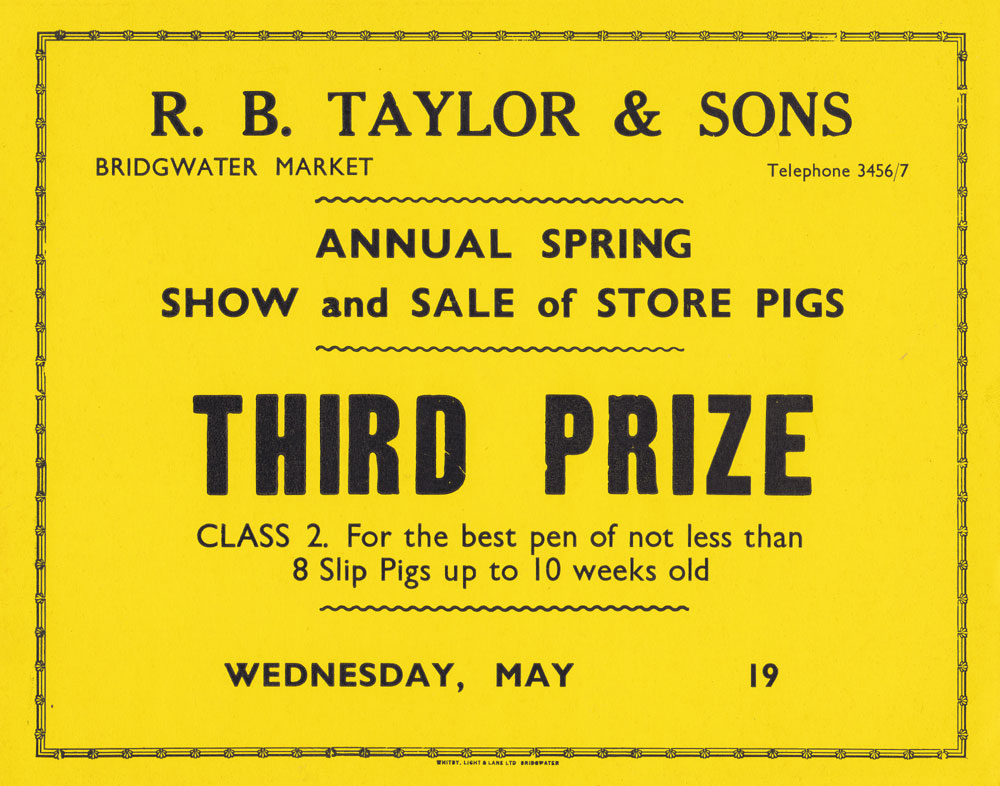
The New Market of Lower Bath Road was laid out and opened in 1935. The Old Market, chiefly a cattle and pig market, had been held at Penel Orlieu on the site now occupied by the art deco cinema, but it had been found to be too small for some years. It was found farmers were increasingly bringing their livestock to the town in lorries, and the Penel Orlieu site was not suited for such traffic. The New Market was intended to address these problems, as well as incorporate the West Street Sheep Market and a corn exchange.
The site was known as ‘Swale Croft’ on the 1804s Tithe map, and was a shrubbery at the time of the 1888 OS map and a ample house ‘the Shrubbery’ had to be demolished to provide the Union Street access to the site.

The Western Daily Press of 4 July 1935 reported: BRIDGWATER’S NEW CATTLE MARKET: Constructed at a cost of £23,000
Bridgwater’s new cattle market, which has been constructed by the Town Council, was opened yesterday by the Mayor (Mr F. J Reed) in the presence of a large concourse of townspeople, agriculturists and reprsentatives of public bodies in the county including the mayors of Taunton and Wells. The new market takes the place of the one which for more than a generation has been held in the centre of the town in Penel Orlieu, with the sale of sheep in West Street. It is situated on the Bath road, near the Great Western Railway, which has sidings running in it for the conveyance of stock. Constructed at a cost of £23.000. including the purchase of land, it covers about six acres, and is laid out he most modern principles. with extensive accommodation for the auctioneers a corn exchange, free car park and buffet, and is considered to be one of the finest markets in the West of England.
Mr R. Ashton, as chairman of the Committee, presided at the opening ceremony, and explained that the new market was required on account of the congestion in the old one, and provision had been made for future expansion. He congratulated the Borough Engineer (Mr R. A. Watson) on his design of the lay-out, and the contractors (Messrs H. W. Pollard and Sons, Bridgwater on the excellent way they had carried out the work.
The Mayor was presented by the contractors with a silver key with which he unlocked the entrance gates and afterwards addressed the gathering and mentioned that Bridgwater had had a chartered market for something like seven centuries. With the coming of the great factory to the town and the opening of this new market they were looking forward to a great future.
Thanks to the Mayor were expressed on the motion of Mr L. H. Palmer (vice-chair-Committee), seconded by Alderman F.G. Haggett, and afterwards refreshments were served to a number of invited guests. Directly the opening ceremony was over’ the sale of sheep was proceeded with, followed by the disposal of the cattle and pigs, conducted by the Bridgwater Market Auction and by Messrs R.B. Taylor and Sons. Yeovil, whilst the visitors made a tour of inspection of the sale rings and buildings.
The July 1935 opening ceremony had included free drink (beer) for attendees. The Bridgwater branch of the Total Abstinence Association sent an angry letter to the council afterwards deploring how intoxicated women returned home too late to get their husbands’ dinners after they had been drinking at the town’s expense, and how women had carried away alcohol in jugs and bottles. The Town Clerk responded by saying this was a scurrilous attack, and how Bridgwater ha one of the smallest hospitality budgets of any town in England (Squibbs’ History, p.128).
The New Market Inn was built by the entrance to the site at the same time, to provide refreshment to the market goers. This was built on the site of ‘Moira Cottage’.
An insight into the operation and development of the market from 1967 can be read below. For a time the abattoir was managed by a company called the Nether Stowey Meat Supply Ltd, later being succeeded by the Bridgwater Beef Company.




It seems most market functions ceased sometime in the late 1990s, although any remaining market operations presumably completely ended in late February/early March 2001, at the time of the Foot and Mouth outbreak, which lasted until the October. The abattoir, however, continued to operate until 2006.
For a number of years, part of the site was home to the Bridgwater Fire Brigade, having moved from Clare Street. Following the relocation of the Fire Brigade to Colley Lane, the former Fire Brigade building was used by the Bridgwater Town Council for it’s Refuse Collection, Cleansing and Vehicle Maintenance base. By 2006 four firms leased parts of the derelict site, including part as a bus depot by Bakers Dolphin.
Several derelict buildings were demolished in January 2007, then a further shed was arsoned nn Monday 1 October 2007.
Planning permission was sought for redevelopment in 2013, granted in 2015 and tweaked in 2018, then construction started in 2018 for 159 new homes.
Two bronze plaques from the main gate piers, one of the town arms, the other commemorating the opening, were removed sometime in the later 2000s and were donated to the Blake Museum by 2011 (BWRAB : 2011/1/49)

MKP 5 Feb 2021.
Additional notes from Mike Searle, Tim Mander, Ann Glover, Kevin Lock, and Dawn Ferguson.
